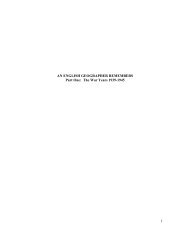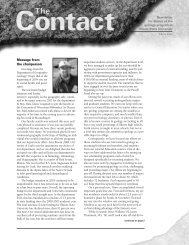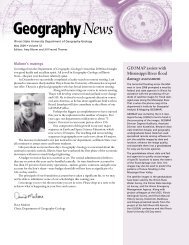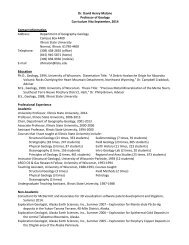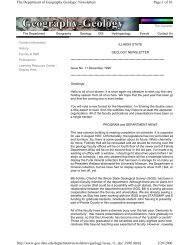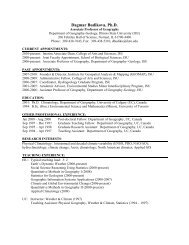Glacial Deposits.indd - Department of Geography - Geology - Illinois ...
Glacial Deposits.indd - Department of Geography - Geology - Illinois ...
Glacial Deposits.indd - Department of Geography - Geology - Illinois ...
You also want an ePaper? Increase the reach of your titles
YUMPU automatically turns print PDFs into web optimized ePapers that Google loves.
At the top <strong>of</strong> the hill, a number <strong>of</strong> people had gathered. Some were tourists, including a bus tour<br />
<strong>of</strong> Japanese. Others were there on a religious pilgrimage. At the top <strong>of</strong> the hill was a very large<br />
statue dedicated to Mary. At the base <strong>of</strong> the statue was a chapel, an outside worship area with<br />
seating, and a shrine where candles could be lit by pilgrims. Some engaged in prayer in these<br />
locations. Chile is 70 percent Catholic, and visible impressions <strong>of</strong> Catholicism on the landscape<br />
are very evident. This includes the religious toponyms (names <strong>of</strong> saints commonly used) and<br />
the large number <strong>of</strong> churches. In addition, I was struck by how the Spanish and later Chileans<br />
used the “highest spots” in the city and country to erect a cross or statue related to the religion.<br />
After some time on the summit <strong>of</strong> the hill, I made the descent. I walked through more <strong>of</strong> Bella<br />
Vista, across the river, and through part <strong>of</strong> the main city park. I observed workers, students, and<br />
street artists/performers along the way. I headed towards the Plaza de Armas, the main square<br />
in Santiago. I found Santiago generally to be an easy city to navigate. As I approached the<br />
Plaza de Armas, I could feel that I was entering an area that was central to the government<br />
(with the presence <strong>of</strong> various government buildings) and also the heart <strong>of</strong> the business district. It<br />
seemed very similar to any American city. Several stores and advertisements were visible for<br />
banks and electronic equipment, similar to how they are commonly found in the CBD <strong>of</strong><br />
American cities. After a bit <strong>of</strong> maneuvering, I made my way to the Plaza de Armas; it was<br />
around 3:00 or so in the afternoon. The plaza looked similar to the main plaza or square in<br />
many big cities—big open space with many people doing different things. The plaza was<br />
surrounded with important government buildings as well as the very large Cathedral de<br />
Santiago, originally built in 1541 with the founding <strong>of</strong> the city. The historic ties between religion<br />
and government were very apparent. A large statue <strong>of</strong> Pedro de Valdivia, Spanish conquistador<br />
and founder <strong>of</strong> Santiago, also was prominently located in the square. The square was nicely<br />
landscaped with palm trees and other vegetation. I looked around and did a bit <strong>of</strong> people<br />
watching—some tourists with cameras close at hand, others businessmen and women on a<br />
break from work, others artists or street performers putting in a day’s work. I took some time to<br />
stroll around the plaza. I went inside the Cathedral de Santiago. The immensity <strong>of</strong> the structure<br />
struck me, as well as the detailed artwork, statues, stained glass windows, and wooden pews. I<br />
looked on the outside <strong>of</strong> the cathedral and noted that it had been rebuilt a handful <strong>of</strong> times due<br />
to earthquakes and damage from Spanish fighting with the indigenous peoples <strong>of</strong> the area.<br />
I next headed to the Mercado Central, which is the central market in Santiago. I always like to<br />
see the major market in an urban area to see what people are selling and buying. After a few<br />
wrong turns (even cartographers make navigation blunders in a foreign environment), I found<br />
the market, which was partially indoors. The main products at the market were seafood and<br />
produce, with various vendors also selling crafts and jewelry. Several restaurants had staff<br />
positioned on the outskirts, trying to entice customers to sit down. I bought my wife a pair <strong>of</strong><br />
earrings made <strong>of</strong> silver and a blue stone unique to Chile. I also picked up some dried apricots<br />
for a snack. I walked away from Mercado Central back towards the Plaza de Armas. As I<br />
wandered, people were getting <strong>of</strong>f work and the streets were becoming crowded. I felt much<br />
immersed in the daily Chilean life in Santiago as I walked along with them. I eventually<br />
wandered into another market, with vendors selling scarves, sweaters, jewelry, etc.<br />
My final stop was Cerro San Lucia, another prominent hill in Santiago, although smaller than<br />
Cerro San Cristobal. The hill was used by the Spanish as a lookout point. The hill was<br />
decorated nicely with fountains, park benches, etc. I made the short ascent to the summit and<br />
took a few minutes to enjoy the view. At this point my feet were tired, and it was getting dark, so<br />
I headed back to the hotel. After a short stop at the hotel, I went out to one final stop for the<br />
night—TelePizza. It was a Friday night, and the pizza place was a popular spot with the younger<br />
crowd, just as it would be in the United States.<br />
27



